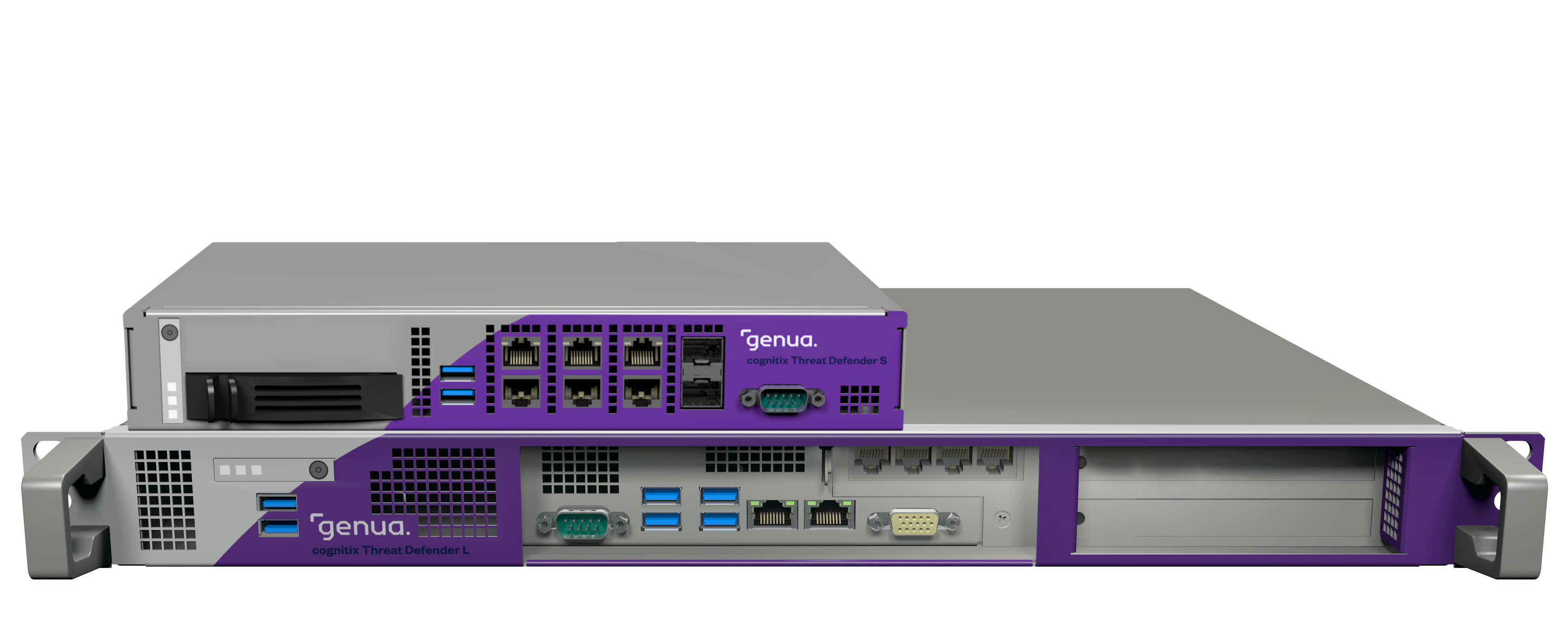System Requirements
Preconfigured Hardware Systems

cognitix Threat Defender S and M/L appliances
genua provides dedicated hardware systems for cognitix Threat Defender. These systems have the following technical specifications:
System |
Mainboard |
CPU |
RAM |
NICs (default) |
|---|---|---|---|---|
Threat Defender S |
Supermicro A2SDi-TP8F |
Intel Atom C3858 12C/12T - 2.0Ghz |
4x 8GB DDR4 2400MHz ECC |
4x 1GbE RJ45 (i350-AM4), 2x 10GbE RJ45 (X557-AT2), 2x 10GbE SFP+ (CS4227) |
Threat Defender M |
Supermicro H12SSW-iN |
AMD EPYC 7272 12C/24T - 2.9-3.2GHz |
8x 16GB DDR4 3200MHz ECC |
2x 1GbE RJ45 (BCM5720L), 4x 1GbE RJ45 (i350-T4) |
Threat Defender L |
Supermicro H12SSW-iN |
AMD EPYC 7402 24C/48T - 2.8-3.35GHz |
8x 32GB DDR4 3200MHz ECC |
2x 1GbE RJ45 (BCM5720L), 4x 1GbE RJ45 (i350-T4) |
For additional information, see the hardware datasheets.
Other Hardware Systems
cognitix Threat Defender is also available as a software-only solution that you can install on your own hardware. To be able to use Threat Defender, your system has to meet the following hardware requirements.
CPU
Intel CPU with SSE 4.2
Minimum of 4 threads, for example
2 CPU cores with hyper-threading
1 CPU with 4 cores
Maximum of 512 threads
Maximum of 8 NUMA nodes (CPU sockets)
RAM
Minimum of 8GB
Recommended 16GB or more
Recommended 2GB per CPU core
Minimum of 8GB per NUMA node
Equal amount of memory on all NUMA nodes
Note
Threat Defender uses DPDK to accelerate processing. DPDK can address a maximum of 512GB RAM. There may be problems if you use considerably larger amounts of RAM.
Network Interface Cards
Minimum of 3 network interfaces in total
Minimum of 2 network interfaces with Intel chipset. If you wish to use chipsets from other vendors, contact support@cognitix.de.
cognitix Threat Defender supports the following Intel chipsets:
Intel 1G: 82575, 82576, 82580, I210, I211, I350, I354
Intel 10G: 82598, 82599, X540, X550, X552/X557 (Niantic)
Intel 10G/40G: X710 (Fortville)
Maximum of 32 Ethernet ports
To achieve optimum performance on an Intel platform, use an Intel Xeon class server system such as Ivy Bridge, Haswell or newer.
Make sure each NIC has the latest version of NVM firmware.
Use PCIe Gen3 slots, such as Gen3 x8 or Gen3 x16, because PCIe Gen2 slots do not provide enough bandwidth for 2 x 10GbE and above.
Disk
SSD recommended
Minimum of 60GB
Recommended 240GB
Installation
Via bootable USB device
The system has to support UEFI
Warning
To be able to get firmware and license updates, the management interface of Threat Defender has to be able to reach our servers via the Internet. If you do not want to connect Threat Defender to the Internet, you need to update it manually (see Updates).